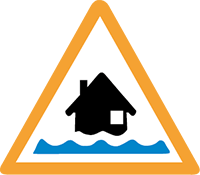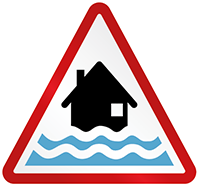Sign up to Floodline
Floodline provides live flooding information and advice on how to prepare for or cope with the impacts of flooding 24 hours a day, 7 days a week. Sign up and get notified when the area you live, work or travel through is at risk of flooding.
| Message Issued | What it means |
|
Flood Alert  |
Flooding is possible. Be prepared. Flood Alerts are issued for regional areas. When is it used? What to do
|
|
Flood Warning  |
Flooding is expected. Immediate action required. Flood Warnings are only issued in local community areas where we monitor river and coastal flooding. When is it used? What to do
|
|
Severe Flood Warning |
Severe flooding expected. Danger to life. When is it used? What to do
|
Check if your property is at risk
-
- Use our flood maps to find out if you're in an area at risk of flooding caused by rivers, the sea or surface water. Flooding can affect more than just your property, it may impact on your community or your route to work so check that too.
- Check you are flood insured.
- If you find it difficult to obtain flood insurance that meets your needs, contact Flood Re. They provide affordable insurance to households at the highest risk of flooding.
Steps to prepare
-
- Follow @SEPAFlood on X for the latest flooding information.
- Check the daily Scottish Flood Forecast for a three day look ahead.
- Sign up to Floodline to receive advance notice of when and where flooding might happen.
- Prepare a flood plan and put a family flood kit together so that everyone knows what to do if flooding happens.
- Familiarise yourself with how to shut off gas, electricity and water supplies.
- Keep a list of useful contact numbers, including your insurance company and utility providers.
- Consider flood protection products for your property and ensure your insurance provides adequate cover for flood damage.
When flooding is forecast
- If you've received a message from Floodline, visit sepa.org.uk/floodupdates for more information including the areas affected and type of flooding.
- Charge your mobile phone.
- Move vehicles out of the flood risk area.
During a flood
- Move important documents and valuable items to a higher place.
- Shut off gas, electricity and water supplies and fit any flood protection products to your property.
- Check on vulnerable and elderly neighbours.
- Move pets and animals to a safe place and ensure they have enough food and water.
- Follow the advice of emergency services and local responders.
- Do not drive or walk through flood water.
After a flood
- Contact your insurance company
- If it's safe to do so, take photographs of the damage caused to your home and valuables. If you need recovery support or advice, contact the Scottish Flood Forum.
- Be aware of the health effects caused by a flood
- Wear appropriate clothing and protection as flood water can be contaminated with harmful bacteria and be mindful of how the stress and traumatic feelings of loss can have an impact on a person's mental wellbeing.
- If repairs need to be made, consider making improvements to make your property more flood resilient.
More advice, videos and materials on how to prepare for flooding are available from the Floodline website.
There's dedicated sections to help you at home, for your business and plan travel.
If you already have an account for Floodline log in to manage your information and find out what areas you're signed up to receive messages for.
